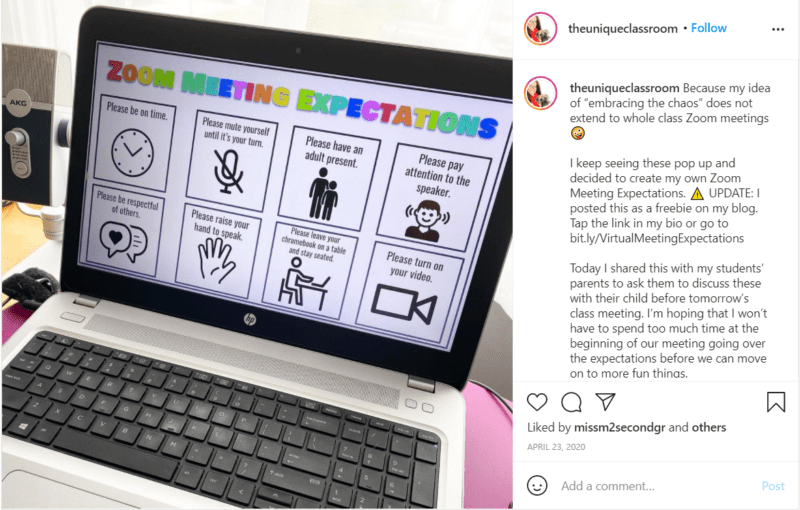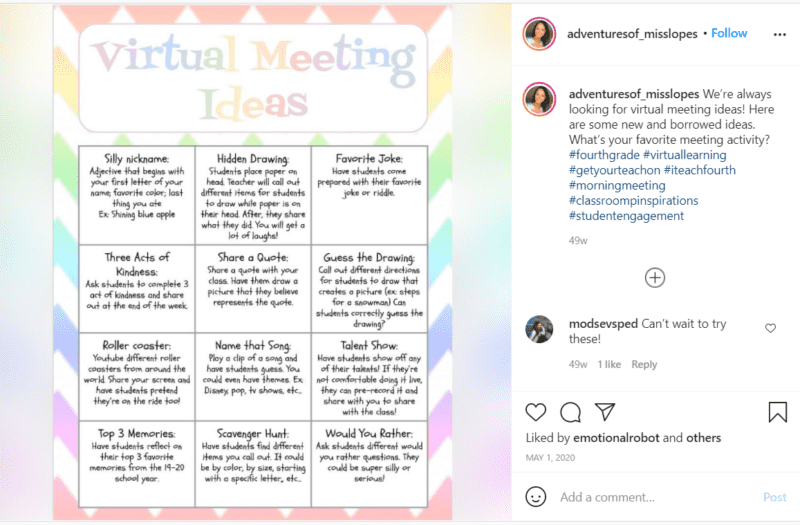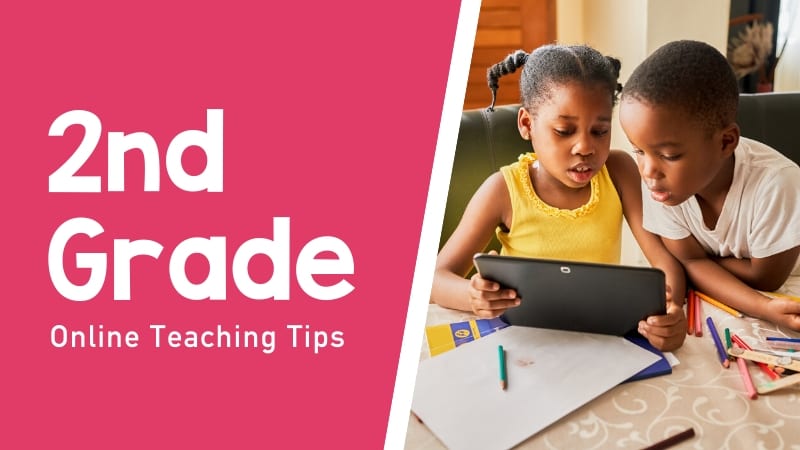Second graders are eager to make sense of the bigger world while they also strive to make their own life as safe and orderly as possible. Have you ever noticed how much second graders enjoy reciting facts about their interests and family life? And how they are horrified by the thought of reading a book series out of order? Second graders retain much of what they learn and will generally work hard to follow instructions and produce quality work. These traits make second graders fun and satisfying to teach, but can also make them more risk-averse and focused on perfection.
In an online learning environment, how do you bring out the best in your second graders and help them cope with an unfamiliar environment? If you’re on the search for helpful resources, you’re probably feeling pretty overwhelmed. We are here to help! We’ve curated the top practical 2nd grade online teaching tips from teachers who are doing their best to be there for students:
Get Ready and Prepared
1. Be there for yourself so you can be present for them
Students learn best from teachers who are calm, centered, and present. For many teachers, entering their classroom in the morning, updating the daily schedule, and organizing the day’s lesson materials are key ways they shift into teaching mode.
At home, switching from home mode to teaching mode might be a bit harder. That’s why it’s essential to create a dedicated space for teaching and establish a consistent teaching routine. Begin by setting up your space with your favorite teaching tools and objects. Many teachers use a corner of a bedroom, an extra card table, or a shared desk in a home office. Size doesn’t matter. It’s the idea of having a designated space and place to keep all your supplies together that’s important. You need to feel this space is your classroom, and that when you arrive, it’s time to teach.

Source: thesassyappleteaching
2. Know thy 2nd grader
Let’s discuss the typical second grader. Generally curious and eager, second graders enjoy mastering new skills and acquiring new knowledge. They are easily motivated and like to be challenged. Second graders can be serious, shy, or moody, but will lighten up with a bit of humor. They are happiest when they know what to expect and have adequate time to complete tasks.
Physically, these 7-8 year olds are becoming more coordinated and discovering new levels of confidence in sports. They’re very active and love to play outdoor games. Fine motor skills and hand-eye coordination continue to develop at this age. Second graders often write and draw in small compact letters and figures, and find it difficult to write big.
In terms of cognitive development, second graders are better at using manipulatives to explain their thinking, so plan for hands-on math and science lessons using household objects or online digital manipulatives (more resources below). They like to sort and classify and enjoy repeating tasks and reviewing their learning. Second graders can wilt under time pressures, so eliminate or minimize timed assignments in favor of allowing students to finish their work during periods of asynchronous learning.
[contextly_auto_sidebar]
3. Join a 2nd grade teacher Facebook group
You’re not the only one navigating 2nd grade online learning, so don’t go it alone—join a group! While every home and school situation is different, online groups can be a good way to build a community of support and to find your teaching people. Just think of it as your online teacher’s lounge. Here are some Facebook groups you might want to check out:
- Lucky 2nd Grade Teachers
- Saddle Up for 2nd Grade
- Second Grade Smiles
- Not So Wimpy Second Grade Teachers
- Second is the Best
Set Up Your Online Classroom
4. Keep an online classroom where everything is organized
Now that you’re ready with your physical space, it’s time to tend to your online classroom. Your district or school may have chosen the platform for you, in which case, stick with it. Parents and kids need to hear a consistent message, so doing it differently might cause confusion.
If you do get to create your own online classroom, keep in mind that it should have the same essential elements as your physical classroom including a place to post assignments, a library of resources, an assignment inbox, and student communication tools. There is an abundance of virtual learning platforms from which to choose.
If your second grade hasn’t been using a Learning Management Systems (LMS) from the start, you’ll need to set it up and consider the best ways to teach how to use it. Many teachers have found that the best way to help students get used to the system is to begin with low-stakes, fun tasks to complete using the LMS.
5. Choose an online video conferencing program, if you are able
During times of online learning, video conferencing can be a powerful way to support young learners and nurture a sense of community. Many schools or school districts choose a video conferencing tool for teachers to use. If you get to choose your own platform, Google Meet and Zoom are popular choices.
Keep in mind that some families may need greater flexibility in their child’s online learning schedule, so avoid requiring students to attend all video conferences. For some teachers, video conferencing with students is not allowed by their school or district. Always follow your school’s guidelines as appropriate.
6. Try a threaded discussion chat
Kids need a predictable structure for how to connect and ask questions. So, if you are unable to do video chats or don’t want to do them every day, try a threaded discussion chat. Try discussion boards like Google Classroom, Blackboard, and Canvas. Another one of our favorite discussion board apps is Padlet.
7. Have set office hours for kids to reach out to you
Second graders need frequent check-ins with a teacher. This isn’t going to change when learning online. They also thrive when schedules and structures are predictable. The simpler you can make it for your students to reach out to you, the more secure they will feel in successfully completing their work. Having regular office hours also helps students feel that you are there for them during this time of online learning.
Manage Your Classroom
8. Engage 2nd graders online based on their development
You’ve got the platforms and systems in place. Now it’s time to actually manage the classroom online. Here are a few quick initial tips:
- Show appreciation and understanding of your students through shout outs, chatbox notes, and one-on-one conversations.
- Give mostly individual or one-partner assignments.
- Break down assignments into manageable parts and be prepared to break them down into even smaller chunks during online learning.
- Take regular movement breaks and create opportunities for students to socialize.
- Stick to predictable daily and weekly schedules.
9. Use your previous lesson plans and pacing guide, but prepare to adapt
Second graders generally take great pride in their work and will want to accomplish online tasks well. However, it may take additional time and effort to help students master online tools, which can make the whole process feel like it’s taking forever. That’s okay. Re-evaluate your lesson plans to include time for students to log in, open documents, start video calls, and complete other technology setup tasks. Looking for ways to strategically avoid time pressures will help reduce frustrations for you and your students.
Keep in mind that your pacing guides were developed with in-person classrooms in mind. It’s awesome if you make it all the way through, but you may also need to slow down if it seems like students are struggling. You may also need to share information in a different way. Second graders tend to dislike taking risks and making mistakes, so keep things light with a bit of humor and support students by talking through any changes you make to the routine.
10. Be consistent about your routines
Building predictable, consistent systems in your online classroom will help your second graders feel comfortable and confident in this new learning environment. Start slowly. At first, keep one simple document with hyperlinks that students can reference and click on to get to the different things they need each day. Weekly checklists can also be an effective way to keep students accountable for assignments while making it easy for parents to know what to expect too.
After you’ve set up standards for where to find things and what’s expected, you can transition to assigning and collecting student work through the LMS and set up your video or threaded message chats there. Ask your students for regular feedback about what’s working and what isn’t. You may need to experiment with a few different organizational strategies before finding the one that’s just right for you and your class.
11. Encourage independence
With support, encourage your second graders to take ownership of their learning. In a classroom space, teachers often help students choose appropriate spaces for reading, writing, and group work. During online learning, students can take on a leadership role in organizing their own learning space and making plans for how and where they will complete school activities.
12. Let 2nd graders do their favorite thing—fact-finding
Second graders are fascinated by the world around them and eager to make sense of it all, so make the most of this natural curiosity. There is an abundance of online resources that allow students to explore everything from marimba music to the hieroglyphics of Ancient Egypt to the sound of a hummingbird snoring! Create opportunities for students to conduct small independent research via safe online platforms and share interesting facts during morning meetings. Video response platforms like Flipgrid make it easy for students to create a whole gallery of fascinating facts for their classmates to discover. Many second graders also enjoy the questions and answers at Wonderopolis.
13. Prioritize student communication & collaboration
Learning remotely is a new experience for students who are used to seeing their teacher every day. If you prioritize student communication, collaboration, and interaction, the quick feedback will reap the benefit of more connected second graders. They are used to getting their answers from you quickly so they can keep going. They’re also used to having your help to stay organized and on task. These needs aren’t going to change.
14. Manage online classroom behaviors
For many second graders, participating in a video conference call will be an unfamiliar experience, so they will need guidance on how to act appropriately. Keep online learning safe, predictable, and positive for students by making your expectations very clear and reviewing them frequently. Make a plan for how you will respond to distractions, rudeness, or other inappropriate behavior.
Many teachers have found it helpful to make a Google slide or PDF document with illustrations and text that outline expected behavior for video conference calls. This free PBIS guide to remote learning behavior can help you put your plan into action. Being intentional about grouping (versus selecting groups randomly) can also help keep some classroom behaviors in check.

Source: @theuniqueclassrooom
Add To Your Classroom
15. Create your own videos when the topic is more difficult
Second grade is a year of steady growth for students’ attention spans. Creating your own videos to explain key concepts will enable you to adjust the length of the video to suit your students. Keep video lessons short (around 5 minutes) at the beginning of the year and aim for longer lessons as the year progresses. Upload these videos to the LMS and add assignments to supplement the material. Students can watch the videos when they can and review them as needed while working on assignments. This is a great way to help your stability-seeking second graders see that you are still there for them as their teacher.
16. Use these online tools that work particularly well with 2nd graders
- Flipgrid: This short video response platform makes it fun for everyone to participate.
- EdPuzzle: Great for getting the most out of video resources.
- Biblionasium: Students can track what they’ve read, write reviews, and discover new books.
- Kahoot: This a prime age for games that let everyone participate synchronously.
- Glencoe Virtual Math Manipulatives: Many 2nd graders benefit from using manipulatives to explain their thinking and problem-solving.
- Seesaw: Students can create digital portfolios of their work that are easy to share with families.
17. Try some games suited to 2nd grader sensibilities
Games can be a great way to build community when students can’t be together in the classroom and on the playground. Second graders are generally good-natured and eager to participate in group activities. Consider scavenger hunts where students bring an item (something yellow, something soft, etc.) to share at the morning meeting. Movement games like yoga, dance parties featuring short selections of different musical styles, and charades are popular with second graders and also offer a great way to get out the wiggles.

Source: @adventuresof_misslopes
18. Explore these 2nd grade resources to add depth to your lessons
Feeling overwhelmed with resources at this point? Then take a break and come back to these later. When you’re ready, you’ll find everything you need to keep your studious, curious, and eager second graders engaged and learning online.
- Terrific Websites, Games, and Activities for Second Graders
- 50 of the Best Books for Second Grade
- 17 Great Learning Podcasts for the Classroom
- 2nd Grade Online Games
- Khan Academy’s Second Grade Math
- Second Grade Math, Language Arts, and Science Videos
- 60+ Awesome Websites for Teaching and Learning Math
- Wonderopolis
- Creative Ways Teachers Are Building Classroom Community Online
What are your favorite 2nd grade online teaching tips? Please share in the comments!
Plus, don’t forget to sign up for our weekly emails to receive more ideas!
Looking for more ways to connect to your second graders? Check out 350+ Amazing Online Learning Resources !


